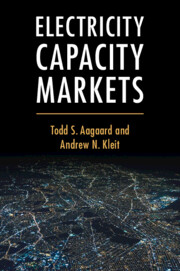Book contents
- Electricity Capacity Markets
- Electricity Capacity Markets
- Copyright page
- Contents
- Figures
- 1 Introduction
- 2 Capacity Markets Primer
- 3 Restructured Electricity Markets and Regional Transmission Organizations
- 4 Reliability and the Missing Money Problem
- 5 Capacity Policies
- 6 First-Generation Capacity Markets
- 7 Second-Generation Capacity Markets
- 8 Capacity Market Demand
- 9 Capacity Market Supply
- 10 Capacity Market Design
- 11 Market Power
- 12 Minimum Offer Price Rules
- 13 The Texas Alternative
- 14 Conclusion
- Index
- References
6 - First-Generation Capacity Markets
Published online by Cambridge University Press: 24 February 2022
- Electricity Capacity Markets
- Electricity Capacity Markets
- Copyright page
- Contents
- Figures
- 1 Introduction
- 2 Capacity Markets Primer
- 3 Restructured Electricity Markets and Regional Transmission Organizations
- 4 Reliability and the Missing Money Problem
- 5 Capacity Policies
- 6 First-Generation Capacity Markets
- 7 Second-Generation Capacity Markets
- 8 Capacity Market Demand
- 9 Capacity Market Supply
- 10 Capacity Market Design
- 11 Market Power
- 12 Minimum Offer Price Rules
- 13 The Texas Alternative
- 14 Conclusion
- Index
- References
Summary
Traditionally state utility regulators ensured adequate capacity to meet peak demand by imposing regulatory capacity requirements on vertically integrated electric utilities. With electricity restructuring in many regions of the country in the 1990s, newly created regional transmission organizations operating under FERC’s purview began to introduce wholesale markets for capacity. This first generation of capacity markets in the Northeast U.S. were viewed as a more flexible means of complying with capacity requirements, rather than as an altogether new capacity policy. Accordingly, the early markets were adopted without considering the underlying question of how best to attain reliability in the new era of competitive electricity markets.
- Type
- Chapter
- Information
- Electricity Capacity Markets , pp. 74 - 91Publisher: Cambridge University PressPrint publication year: 2022

